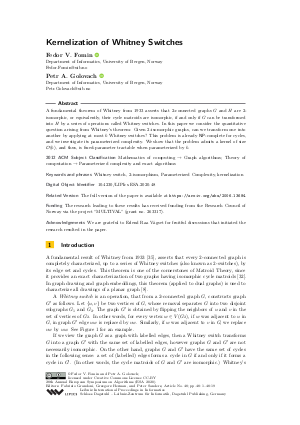LIPIcs.ESA.2020.48.pdf
- Filesize: 0.72 MB
- 19 pages

 Creative Commons Attribution 3.0 Unported license
Creative Commons Attribution 3.0 Unported license

A fundamental theorem of Whitney from 1933 asserts that 2-connected graphs G and H are 2-isomorphic, or equivalently, their cycle matroids are isomorphic, if and only if G can be transformed into H by a series of operations called Whitney switches. In this paper we consider the quantitative question arising from Whitney’s theorem: Given 2-isomorphic graphs, can we transform one into another by applying at most k Whitney switches? This problem is already NP-complete for cycles, and we investigate its parameterized complexity. We show that the problem admits a kernel of size 𝒪(k), and thus, is fixed-parameter tractable when parameterized by k.







Feedback for Dagstuhl Publishing